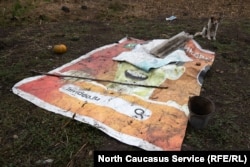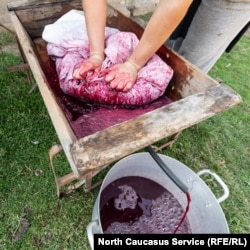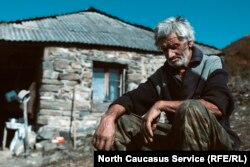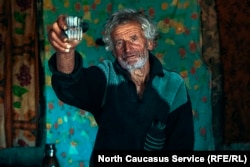Ethnic Georgians and Ossetians have lived side-by-side for centuries in South Ossetia. Their cultures are similar, and both value hospitality and share a love of long feasts. But relations became strained after the collapse of the Soviet Union when the territory broke away from Georgia. Russia-backed separatists control the region that Moscow recognized as an independent state after a five-day war against Georgia in 2008.
Sunset on South Ossetia’s Mount Mtatsminda, or Sacred Mountain. Ruins of a church sit on the peak overlooking the Mejida Valley. A century ago, the area was very populated, but people gradually left as the region declined.
An old school in the village of Bikar. Before the collapse of the Soviet Union, Georgians made up about 30 percent of South Ossetia’s population. People of different ethnicities got married and got along. But then came conflict, and communities were torn apart.
Families have been split by the administrative boundary line that separates Georgia and South Ossetia. “My children, my sisters, and brothers live in Georgia,” says ethnic Ossetian Izolda who lives in the village of Vilda. “Seventeen kilometers separate us, but we don’t see each other anymore.” Some people try to cross the boundary line illegally but run the risk of being captured by guards.
Following the 2008 war, Georgia lost more territory to separatists near South Ossetia’s de facto capital city, Tskhinvali.
People in the region complain about corruption, social problems, and being cut off from Georgia. From the mountains, they can see the highway that leads to the Georgian city of Mtskheta. But the local road leading to highway has been closed for a long time.
Red grapes being pressed for their juices. Wine is an important part of both Ossetian and Georgian cultures. So too is churchkhela, a traditional candy made from grapes and walnuts.
Kazbeg sits in front of his home.
The moment company arrives, Kazbeg fetches something to drink for his guests.
Kazbeg's wife is making cheese.
The Dvalishvili family enjoying wine at their home in the village of Ardisi.
Givi Dvalishvili is a devout Christian and kisses each corner of the local church before entering.
Bells are placed above the entrance of the church. Givi walks inside after ringing a bell. He is ethnic Georgian and his wife is ethnic Ossetian. They are among many mixed couples in the region.
Givi and our Ossetian guide, Renat, light candles inside the church.
Givi inside the local church. According to legend, an old family tower used to stand on the site. An avalanche demolished it, but locals were amazed that a silver cross was left standing. They decided to build a church to replace the tower.














